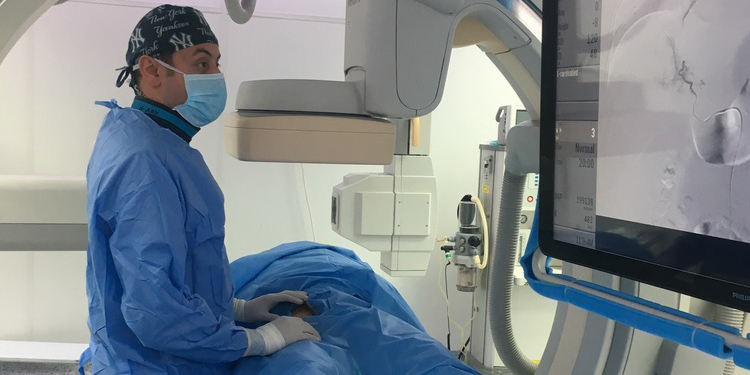
Overview
What Are Varicose Veins?
Varicose veins are superficial veins located close to the skin's surface, characterized by stretching, dilation, and twisting. They develop when valves in the legs become incompetent, causing blood to pool in the legs and resulting in a burning or aching sensation. Approximately 25 percent of women and 15 percent of men experience varicose and spider veins. While common, varicose veins are typically not a serious issue, and the risk of blood clots developing in them is rare.
What are spider veins?
Spider veins, or telangiectasias, are small, dilated veins that often appear near the skin's surface, resembling a spider's legs. Typically found on the legs and face, they are usually a cosmetic concern. While not associated with pain, some may experience mild burning or itching. Factors like genetics, hormonal changes, pregnancy, and prolonged sitting contribute to their development.
Symptoms of Varicose Veins
- Bleeding - While rare, varicose veins can lead to bleeding, especially after minor injuries.
- Bulging, Purplish, or Bluish Veins - The appearance of enlarged, discolored veins is a common visual indicator.
- Heaviness or Aching Discomfort - Standing for extended periods can cause discomfort in the legs, which often eases with leg elevation.
- Itching/Rashes - Some individuals may experience itching or develop rashes around the affected veins.
- Leg Swelling - Varicose veins may contribute to swelling in the legs, particularly after prolonged periods of sitting or standing.
- Skin Discoloration and Changes - Over time, skin near affected veins may undergo discoloration or exhibit changes in texture.
- Superficial Blood Clots (Superficial Phlebitis) - Occasionally, varicose veins can be associated with the formation of superficial blood clots, leading to localized inflammation.
Understanding the Diagnoses of Varicose Veins
Diagnosing varicose veins involves a comprehensive evaluation to identify and assess the condition. Typically, the diagnostic process includes a combination of medical history, physical examination, and imaging tests. Here's a breakdown of the key components:
- Medical History:
- Gathering information about the patient's medical history, including any family history of vein-related issues.
- Understanding symptoms such as pain, swelling, itching, or skin changes in the legs.
- Physical Examination:
- Conducting a thorough examination of the legs to visually assess the veins.
- Palpating the legs to check for tenderness or swelling.
- Evaluating the patient's ability to stand and walk without discomfort.
- Imaging Tests:
- Utilizing imaging techniques, especially ultrasound, to get a detailed view of the veins.
- Assessing blood flow patterns, identifying valve functionality, and locating any areas of blockage.
Seeking professional medical advice is crucial for an accurate diagnosis. If symptoms or risk factors are present, a timely diagnosis ensures appropriate management and treatment strategies for varicose veins.
Understanding the Causes of Varicose Veins
Varicose veins develop when veins become enlarged, dilated, and twisted. While the exact cause isn't always clear, several factors contribute to their formation. Here's an overview:
Genetics:
Varicose veins often have a hereditary component, running in families.
Vein Valve Dysfunction:
When valves within veins weaken or fail to close properly, blood can pool, increasing pressure on vein walls.
Increased Pressure:
Pooled blood in the lower legs elevates pressure against vein walls, causing them to stretch and bulge.
Muscle Support and Weak Walls:
Superficial veins have minimal muscle support, making them susceptible to stretching. Weak vein walls contribute to the development of varicose veins.
Risk Factors:
Factors like congenital vascular malformations, a family history of varicose veins, and hormonal changes in women may increase the risk. Conditions such as obesity, deep vein thrombosis, and pregnancy can also contribute.
Varicose Vein Treatments
Varicose veins, while often benign, can cause discomfort and affect appearance. Several treatments are available to manage and alleviate symptoms. Here are common approaches:
- Complementary and Supportive Therapy
- Endovenous Laser Vein Ablation
- Microphlebectomy
- Sclerotherapy
- Surgical Vein Ligation and Stripping
Complementary and Supportive Therapy
Incorporating complementary or supportive therapies into cardiovascular procedures can enhance recovery and provide nonsurgical relief. Here are some widely recommended strategies:
Prescription Compression
Utilize compression bandages or stockings to facilitate blood flow back to the heart.
Elevation
Raise legs or arms above heart level to reduce swelling.
Activity Management
- Avoid Prolonged Standing: Minimize standing for extended periods.
- Daily Exercise: Engage in approved daily exercises to promote circulation.
- Weight Loss: If applicable, work on weight management.
Topical Wound Care
Use topical wound care measures to support healing.
Unna Boot
Employ an Unna boot, a moist gauze bandage, for enhanced healing, improved blood return, and reduced infection risk.
Endovenous Laser Vein Ablation
Overview: Endovenous laser vein ablation serves as a minimally invasive alternative to surgical interventions for varicose veins. It involves the application of laser-generated heat to seal problematic veins.
Procedure Advantages:
- Outpatient setting.
- Shortened recovery period.
- Minimal to no scarring.
- Excellent treatment outcomes.
Post-Procedure Guidelines:
- Wear compression stockings for three weeks.
- Resume most activities within a day or two.
Sclerotherapy
Overview: Sclerotherapy, suitable for spider veins and some larger veins, involves injecting a solution into veins to prompt collapse and disappearance.
Pre-Procedure:
- Avoid aspirin for five days before treatment.
- Obtain prescribed compression stockings in advance.
Post-Procedure:
- Wear compression stockings for several days to two weeks.
- Return to routine activities immediately.
Dressing and Wound Care:
- Follow specific dressing removal instructions.
- Avoid sun exposure to prevent hyperpigmentation.
- Monitor legs for signs of healing and address any concerning symptoms promptly.
Exercise After Sclerotherapy:
- Avoid high-impact aerobic activities for the first week.
- Walk for at least 30 minutes daily to promote healthy vein growth.
- Gradually resume normal exercise after one week, ensuring continued use of compression stockings, even during workouts.
Note: Patient adherence to prescribed compression stockings is crucial for procedural success.
